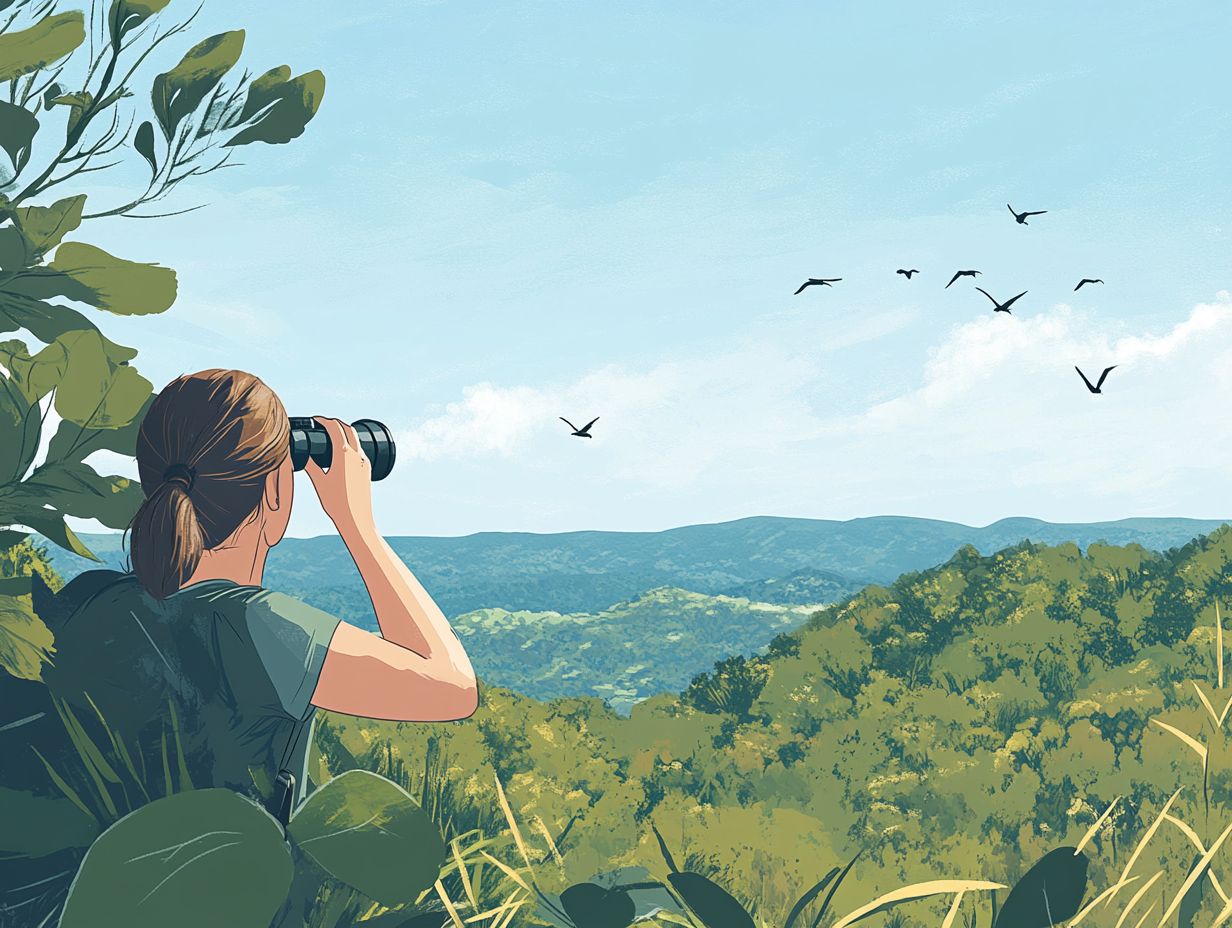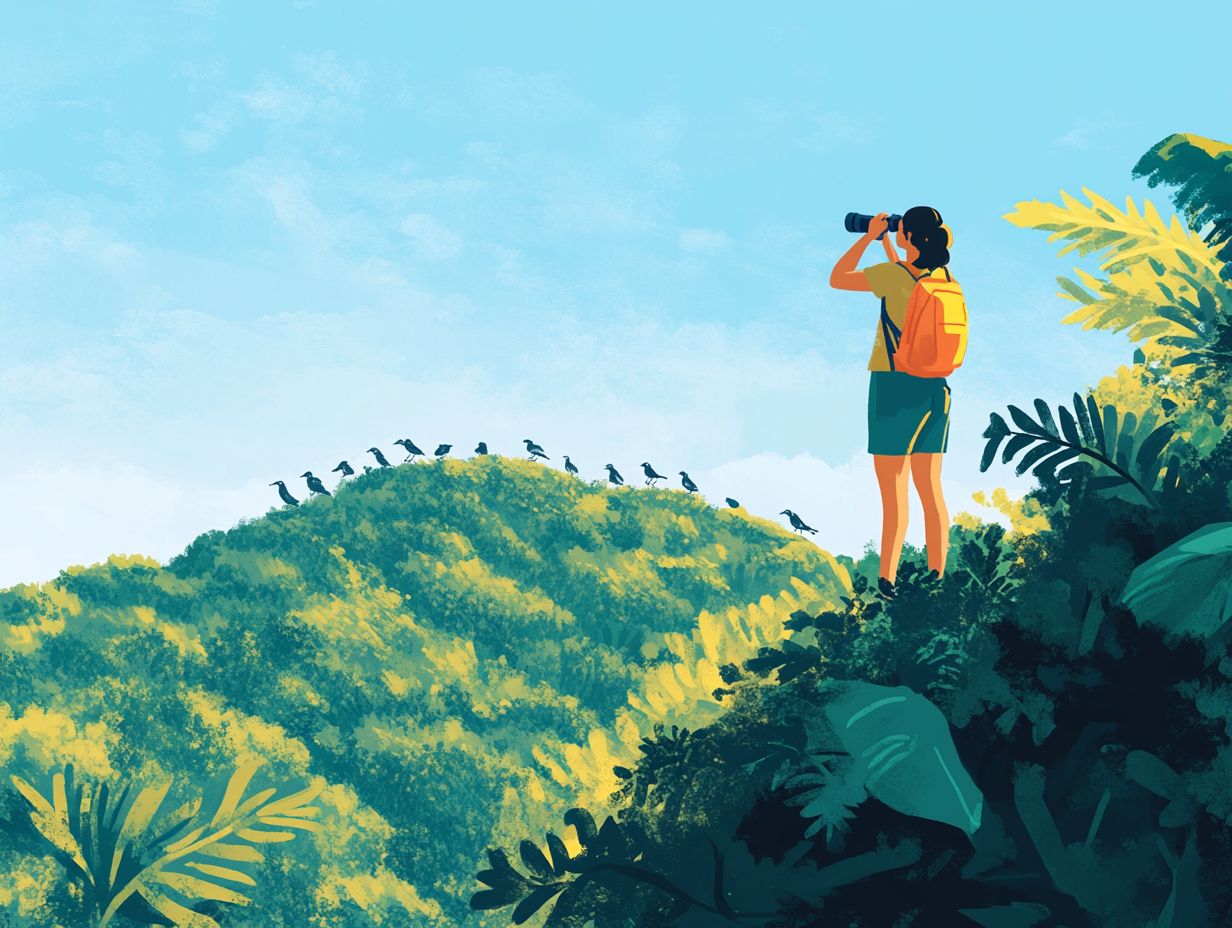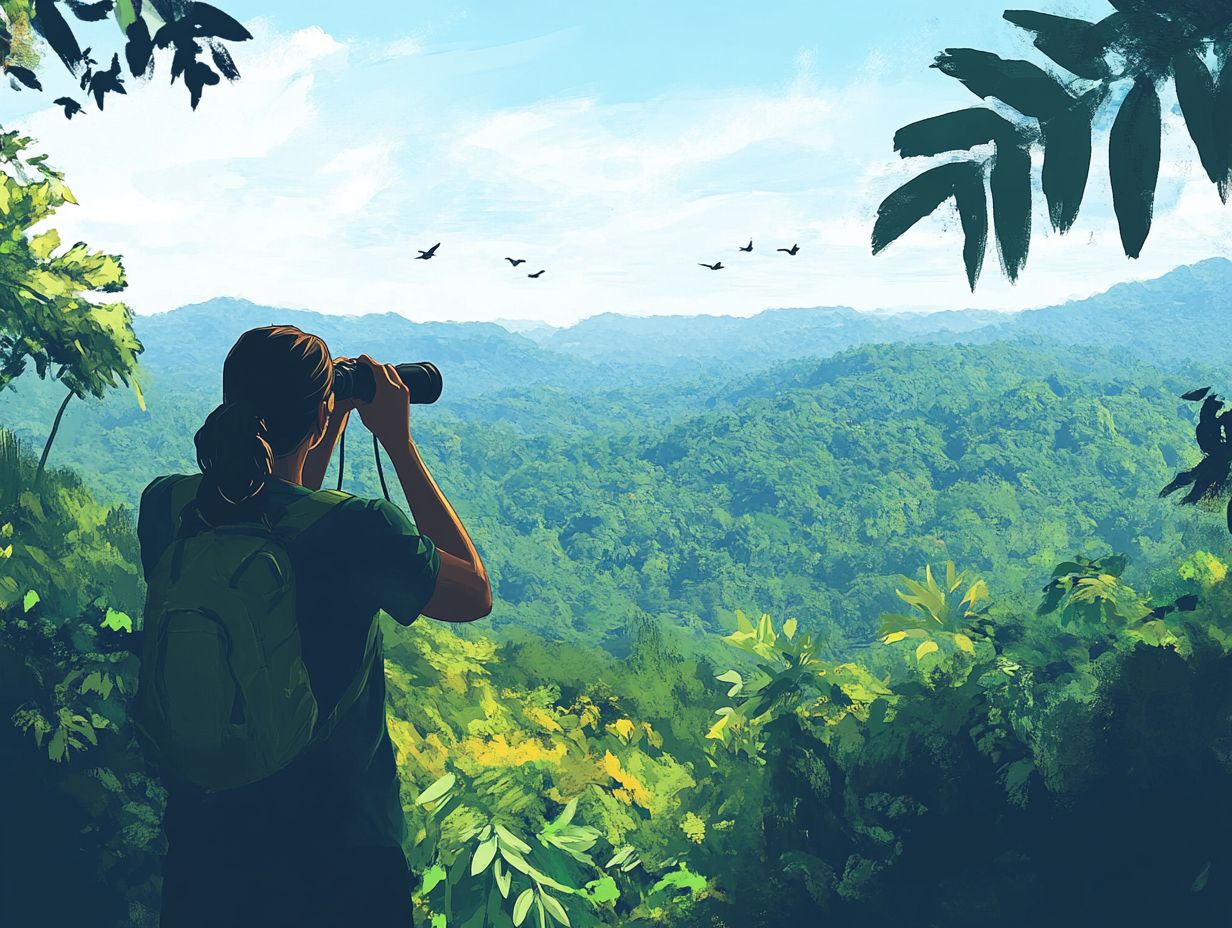How to Spot Birds from a Distance?
Bird watching is a captivating hobby that deepens your connection with nature while honing your observational skills.
Whether you’re just starting out or aiming to refine your techniques, grasping the fundamentals can significantly elevate your experience.
From selecting the perfect binoculars to identifying bird species by their distinctive traits and habitats, this guide encompasses all the knowledge you need to enhance your birding techniques.
It also offers insightful birdwatching tips for improved spotting and outlines common pitfalls to steer clear of, ensuring your birding adventures are not only enjoyable but also successful.
Contents
- Key Takeaways:
- Benefits and Basics of Bird Watching
- Tools for Spotting Birds from a Distance
- Identifying Birds by Physical Characteristics
- Identifying Birds by Habitat and Location
- Tips for Better Bird Spotting
- Common Mistakes to Avoid
- Frequently Asked Questions
- What are some characteristics to look for when trying to spot birds from a distance?
- Is it better to use binoculars or the naked eye to spot birds from a distance?
- What are some common mistakes people make when trying to spot birds from a distance?
- Are there specific habitats or locations better for spotting birds from a distance?
- How can I improve my chances of spotting rarer or elusive birds from a distance?
- What are some tips for spotting birds from a safe distance without disturbing them?
Key Takeaways:

- Invest in high-quality binoculars and other essential equipment for bird watching from a distance.
- Pay attention to physical characteristics such as color, size, shape, and behavior to identify different bird species.
- Understand bird habitats and migration patterns to increase your chances of spotting specific birds from a distance.
Benefits and Basics of Bird Watching
Engaging in bird watching, often called birding, presents a multitude of benefits that extend far beyond merely observing diverse bird species in their varied habitats.
Bird watching deepens your appreciation for nature. It also builds a vibrant community of local birders and bird enthusiasts who are united by a shared commitment to bird conservation and awareness.
As you venture outside, you forge a connection with the environment, attune your ears to the unique melodies of various birds, and hone your skills in bird identification. You ll find bird watching is not just fun it s incredibly rewarding!
Tools for Spotting Birds from a Distance
To spot birds from afar, equipping yourself with the right tools is essential for improving your birdwatching experience and observation skills. High-quality binoculars and spotting scopes are critical companions for any serious birder.
These instruments allow you to observe various bird species without intruding on their natural behaviors, enabling true nature observation. Birdwatching apps and guides provide invaluable insights into bird locations, including backyard birding and local habitats, as well as identification techniques, further enhancing your knowledge.
Leveraging platforms like eBird can enrich your outdoor excursions by allowing you to log your sightings and connect with a vibrant birding community, engaging with local birders and birding clubs.
Binoculars and Other Essential Equipment
To truly immerse yourself in the art of bird watching, investing in a quality pair of binoculars and mastering binocular adjustments is essential. They significantly enhance your ability to observe birds from afar, letting you appreciate their unique songs and captivating behaviors.
If you’re aiming to catch a glimpse of elusive or distant species, a spotting scope can further expand your range of visibility, making every outing more rewarding.
Mastering the proper adjustments on your binoculars is crucial for achieving the clearest image and ensuring a comfortable experience during your birdwatching adventures.
When you’re in the market for binoculars or a spotting scope, consider key features like magnification, objective lens diameter, and field of view. These elements play a vital role in clarity and brightness, enhancing your overall birdwatching experience. Binoculars with an 8×42 configuration are often the go-to choice for their perfect balance between magnification and stability, while a 60mm spotting scope shines in low-light conditions.
Don’t overlook the quality of the lens coatings; they can greatly impact light transmission and minimize glare. Additionally, adjusting the eyecups according to your vision needs whether you wear glasses or not and fine-tuning with the diopter ensures a crystal-clear view. This attention to detail will elevate your experience, ultimately enhancing your success in identifying and reveling in the delicate wonders of avian life.
Identifying Birds by Physical Characteristics

Identifying birds by their physical characteristics is essential for birdwatchers. This skill helps you differentiate between various species based on color, size, shape, and unique behaviors.
Familiarity with bird calls is also important. Each species often has distinct audio cues that aid in identification and improve your birding techniques.
By honing these skills, you enhance your birdwatching experience. You also position yourself to contribute meaningfully to bird conservation efforts.
Color, Size, Shape, and Behavior
The color, size, shape, and behavior of birds are crucial for identification. These traits reveal not only the species but also the bird’s role within its habitat.
For example, vibrant plumage may indicate a courting display. Size can hint at dietary preferences or nesting habits.
Consider the striking red shoulder of a Red-shouldered Hawk in spring migration. Males display vivid colors to signal fitness and readiness to establish territory.
Size variations among sparrows reveal much about their feeding strategies. A larger Fox Sparrow forages for roots and insects, while a smaller Song Sparrow prefers seeds.
Seasonal changes can complicate these patterns. Some species alter behaviors during migrations, showcasing their adaptability and ecological significance.
Identifying Birds by Habitat and Location
Understanding bird habitats and locations is essential for birdwatchers to improve identification skills. Different species flourish in various environments, from wetlands to forests.
Being aware of migration patterns enriches your birdwatching experience, especially during peak seasons when specific species, like hawks and eagles, arrive in your area.
Engaging in local tours and utilizing resources like field guides can deepen your connection to nature and elevate your identification skills.
Understanding Bird Habitats and Migration Patterns
Understanding bird habitats and migration patterns is essential for pinpointing where to find specific species throughout the year, especially during the lively spring migration.
Wetlands, forests, and grasslands each attract a variety of species, offering you diverse opportunities for observation. By being aware of these patterns, you can track bird locations and elevate your birdwatching experience.
Different ecosystems act as crucial waypoints for migratory species. Wetlands draw waterfowl like ducks and geese, while forests host colorful songbirds such as warblers and thrushes. Grasslands serve as ideal nesting sites for raptors and ground-nesting birds.
Consider notable migratory birds like the Arctic Tern and loons, renowned for their remarkable journey between breeding and wintering grounds. Tracking these patterns not only enriches your birdwatching adventures but also deepens your understanding of avian ecology.
So, get outside! Observe the fascinating world of birds and put your new identification skills to the test!
Tips for Better Bird Spotting

Enhancing your bird spotting skills can transform your birdwatching experience into something truly enjoyable and rewarding. Employing effective birdwatching techniques is crucial for excelling in this delightful outdoor pursuit.
Engage in practice using binoculars to sharpen your observational skills. Focus on refining your ability to recognize audio cues and bird calls. Every effort you make will significantly boost your chances of spotting elusive birds across varied habitats while immersing yourself in the soothing sounds of nature, from the unique songs of bluebirds to the calls of kestrels.
Techniques and Strategies for Successful Bird Watching
Successful bird watching requires a blend of techniques and strategies that enhance your overall experience. Start with the essential virtues of patience and keen observation.
Tune into bird calls and audio cues to alert yourself to nearby species. Adopting a meandering pace during your walks allows you to spot birds that might otherwise go unnoticed. These tips are invaluable for anyone eager to deepen their connection with birds and contribute to wildlife conservation.
Investing in proper equipment, such as high-quality binoculars and comprehensive field guides, can elevate your experience to new heights. Stealth is equally important; moving quietly and blending into your surroundings facilitates more authentic encounters.
Picture the thrill of spotting a vibrantly colored warbler or a majestic hawk on a bright morning. As it flitted about, those fleeting moments reaffirmed the joy of being fully present in nature.
Develop a sharp eye to notice subtle movements in bushes and trees. This can make the difference between a chance sighting and a breathtaking glimpse of something extraordinary. Immerse yourself in the tranquility of your surroundings to cultivate patience and a deeper appreciation for the wonders of wildlife.
Common Mistakes to Avoid
Understanding the common mistakes to avoid while bird watching is essential for elevating your overall experience and honing your bird identification skills.
Whether it s misidentifying species from mere glimpses or missing critical behavioral cues, being aware of these pitfalls will make you a more perceptive observer in the field.
Learn from the experiences of others to refine your skills and deepen your enjoyment of wildlife observation. Make each outing a richer and more rewarding adventure.
Errors that Can Affect Bird Identification
Mistakes in bird identification can create confusion that impacts your overall birdwatching experience. Factors such as poor visibility, hasty conclusions, and a lack of awareness about specific characteristics can all contribute to misidentifications.
Being thorough and employing effective bird identification strategies will minimize these errors and deepen your connection to wildlife.
Common pitfalls, like confusing similar species, often arise from rushed observations. For example, mistaking a male American Robin for a female, when both exhibit different plumage, could hinder your understanding. Factors such as distance from the observing area or the time of day can obscure critical details like coloration and markings.
To improve your accuracy, take a moment to scrutinize unique features like beak shape and tail length. Cultivating patience and honing your observational skills will enrich your knowledge and immerse you in the wonders of bird life.
Watch this video to learn more about birdwatching techniques and tips!
Frequently Asked Questions

This section addresses common queries related to birdwatching, helping you enhance your experience and understanding.
Grab your binoculars and head outside to start your adventure! Share your birdwatching experiences or tips in the comments below.
What are some characteristics to look for when trying to spot birds from a distance?
When spotting birds, look for unique features like size, shape, and color. To enhance your experience, check out tips on how to spot birds in urban areas. Notice the bird’s silhouette, beak shape, and any special markings.
Is it better to use binoculars or the naked eye to spot birds from a distance?
Binoculars enhance your ability to see birds from afar, revealing details that the naked eye may miss. To maximize this experience, consider using binoculars effectively for bird identification, which helps identify birds without startling them.
What are some common mistakes people make when trying to spot birds from a distance?
Relying only on color for bird identification is a common mistake. Many birds have various color forms, so also consider size and shape.
Focusing too much on the bird itself and not its surroundings can lead to missed identification clues.
Are there specific habitats or locations better for spotting birds from a distance?
Birds thrive in various habitats, but some areas attract more species. Look for places with diverse plants, open fields for perching, and water bodies.
Migratory birds often follow specific routes, so check the best times and locations to spot them.
How can I improve my chances of spotting rarer or elusive birds from a distance?
Patience is key in spotting rare birds. Research their habitats, behaviors, and calls beforehand for better chances of success.
Joining a birding group or hiring a guide can significantly enhance your experience.
What are some tips for spotting birds from a safe distance without disturbing them?
Respecting birds and their habitats is vital. Stay on trails, avoid loud noises, and don t get too close.
Use binoculars or spotting scopes for observation and always practice leave-no-trace principles.






